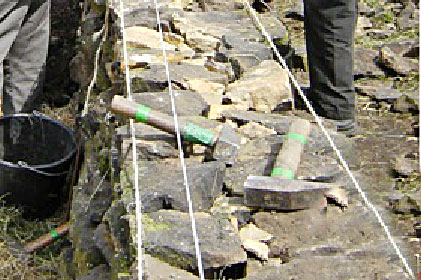Tools For Building A Dry Stone Wall
Assuming you intend to use traditional techniques for building the wall (i.e. without the use of cement or other artificial bonding agents) and depending on the location, size and complexity of the structure you plan to make, you will need a selection of the following equipment:
- Hammer
This is required to dress the stones, particularly the cap stones for finishing off the top of the wall. There are various designs but essentially a dry stone walling hammer has a broad chisel shaped edge, which may be parallel to the shaft or at right angles, depending on the design. - Hammer and chisel
It may seem inappropriate to purchase a special hammer for a small job, in which case an acceptable alternative is to use a club hammer and a wide chisel. Obviously using two tools requires both hands and therefore the work is likely to take longer than using a hammer that is designed for the job. - Gloves, goggles, reinforced boots and knee pads
These are required for safety and for comfort when handling and dressing large stones - Wooden "A" Frames, lines, plumb line and spirit level
These are required to keep the wall straight and vertical. The "A" frames are constructed from rough wood to the height and widths (top and bottom) of the finished wall. The lines are used between the "A" frames as guides when laying each course of stones. - Moving and transporting equipment
you will find items such as strong buckets for carrying smaller stones and crow bars useful when moving large heavy stones into position - Spade or shovel to dig the foundation trench

Think Safety
In addition, you should appreciate that dry stone walling involves lifting and moving large quantities of heavy stone. Consequently you would be wise to learn and practice safe manual handling techniques (See Safety in the Garden). After all, the satisfaction of building your own dry stone wall is little compensation if you end up with serious injury to your back or limbs.
Read more about Dry Stone Walling |
Read about more Gardening Techniques |
